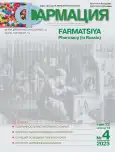Study of morphological and micro-diagnostic signs of the alfalfa crescent herb (Medicago falcata L.)
- Authors: Shvets N.N.1, Bubenchikov R.A.1, Pascar I.V.1
-
Affiliations:
- KSMU Ministry of Health of the Russian Federation
- Issue: Vol 72, No 4 (2023)
- Pages: 16-22
- Section: Pharmaceutical chemistry and pharmacognosy
- URL: https://journals.eco-vector.com/0367-3014/article/view/567938
- DOI: https://doi.org/10.29296/25419218-2023-04-02
- ID: 567938
Cite item
Abstract
Introduction. Alfalfa crescent (Medicago falcata L.) is widespread in the regions of the middle belt of Russia. It is not used in official medicine, because there is no normative documentation for its herb raw material. In this regard, the study of morphological and microdiagnostic signs of alfalfa crescent herb is relevant
Objective. Is to develop the characteristics of the authenticity of Alfalfa crescent herb (morphological and microscopic signs of raw materials) to form the relevant sections of the regulatory documentation.
Material and methods. The selected object of the study was Alfalfa crescent herb harvested in 2020–2022 in the vicinity of Marshal Zhukov G.K. settlement in Kursk Region. Microscopic studies of Alfalfa crescent herb raw material were carried out using temporary preparations prepared from different parts of raw material. Microscope «Micromed C1 Led» with a digital attachment was used to obtain photos and study the micro preparations.
Results. The external (morphological) signs of raw material and its microdiagnostic signs are established. Under stem epidermis there are crystals and cells with brown contents. The stomata are of the anomocyte type. The epidermis of the stem, compound leaflets, and calyx is pubescent with two-celled thick-walled hairs with finely and coarsely cuticle with a slightly widening base. Around the base of setae, epidermal cells form a rosette of 7–9 cells. Along the calyx and vein of the compound leaflets, a crystalline overlay is found. Papilla-shaped outgrowths of epidermal cells are located along the edge of the calyx teeth and the upper part of the corolla. Beneath the epidermis of the calyx, bacilliform prismatic calcium oxalate crystals are located.
Conclusion. Our studies have provided new information about morphological and anatomical features of the Alfalfa crescent herb.
Full Text
About the authors
Natalya Nikolaevna Shvets
KSMU Ministry of Health of the Russian Federation
Author for correspondence.
Email: nataliashvetzneo@mail.ru
ORCID iD: 0000-0003-4550-781X
postgraduate student of the Department of Pharmacognosy and Botany
Russian Federation, St. K. Marx, h. 3, Kursk, Kursk region, 305041Roman Aleksandrovich Bubenchikov
KSMU Ministry of Health of the Russian Federation
Email: robub@bk.ru
ORCID iD: 0000-0003-0955-6892
Doctor of Pharmaceutical Sciences, Head of Standardization and Implementation of Scientific Developments, Standardization and Implementation of JSC «Scientific-Production Association on Medical and Immunobiological Preparations «Microgen»»
Russian Federation, St. K. Marx, h. 3, Kursk, Kursk region, 305041Irina Vladimirovna Pascar
KSMU Ministry of Health of the Russian Federation
Email: paskar_irina@farmoborona.ru
ORCID iD: 0000-0003-2706-4891
Candidate of Pharmaceutical Sciences, General Director of LLC EC "PHARMOBORONA"
Russian Federation, St. K. Marx, h. 3, Kursk, Kursk region, 305041References
- Kovalev S. V. Chemical study of the lipophilic fraction of alfalfa crescent grass. Zaporozhye medical journal. 2013; 3 (78): 94–7 (in Russian)].
- Babaskina L.I. Pharmacognostic study of genera alfalfa, lupine, vetch of the legume family, the prospect of their practical use: Doctor of Pharmacy dissertation. Moscow, 1998; 48 (in Russian)].
- Javid T., Adnan M., Tariq A., Akhtar B., Ullah R., Abd El Salam N.M. Antimicrobial activity of three medicinal plants (Artemisia indica, Medicago falcate and Tecoma stans). African Journal of Traditional, Complementary and Alternative Medicines. 2015; 12 (3): 91–6.
- Flora of the USSR. Т. 11. Ed. by Acad. V. L. Komarov; binding and flyleaf: V. K. Isenberg; Botanical Institute of the Academy of Sciences of the USSR. Leningrad: ed. and type. Publishing House of the Academy of Sciences of the USSR. 1945; XVII: 432 (in Russian)].
- Maevsky P.F. Flora of the middle belt of the European part of Russia: 11th ed. M.: KMC Scientific Publishers Association, 2014; 157–9 (in Russian)].
- Malysheva N.Yu., Malyshev L.L. Analysis of the level of mobilization of the Medicago falcata sl complex on the territory of the USSR. Trudy po prikladnoy botanike, genetike i selektsii. 2020; 181 (3): 17–24 (in Russian)].
- Singer S.D., Subedi U., Lehmann M., Burton Hughes K., Feyissa B.A., Hannoufa A., Shan B., Chen G., Kader K., Ortega Polo R., Schwinghamer T., Kaur Dhariwal G., Acharya S. Identification of Differential Drought Response Mechanisms in Medicago sativa subsp. sativa and falcata through Comparative Assessments at the Physiological, Biochemical, and Transcriptional Levels. Plants (Basel). 2021; 10 (10): 2107. doi: 10.3390/plants10102107.
- Shvets N.N. The study of nitrogen compounds of alfalfa sickle grass (Medicago falcata L.). Collection of X International Scientific-Practical Conference of Young Scientists "Modern trends in health saving technologies". 2022; 394–8 (in Russian)].
- State Pharmacopoeia of the Russian Federation. XIV edition. Vol.4. Moscow: Federal electronic medical library, 2018. 1833с. URL: http://femb.ru/femb/pharmacopea.php. [State Pharmacopoeia of the Russian Federation. XIV edition. T.4. Moscow: Federal Electronic Medical Library, 2018; 1833 (in Russian)].
- Kovaleva NA, Trineeva OV, Gudkova AA, Kolotneva AI, Nosova DK The study of microdiagnostic signs of sea buckthorn leaves. Pharmacy 2022; 3 (71): 18–23. DOI: https://doi.org/10.29296/25419218-2022-03
- Garcia, ER, Eliseeva LM, Shamilov AA, Shcherbakova EA, Konovalov DA Comparative study of macro- and microscopic structures of different organs of tartaric thorn and milk thistle. Kursk scientific and practical newsletter "Man and his health". 2019; 4: 104–14 doi: 10.21626/vestnik/2019-4/13
- Shvets N.N., Bubenchikova N.N. Investigation of flavonoids of sickle alfalfa herb (Medicago falcata L.). Farmatsiya. 2022; 71 (8): 15–20. DOI: https://doi.org/10.29296/25419218-2022-08-02
Supplementary files








